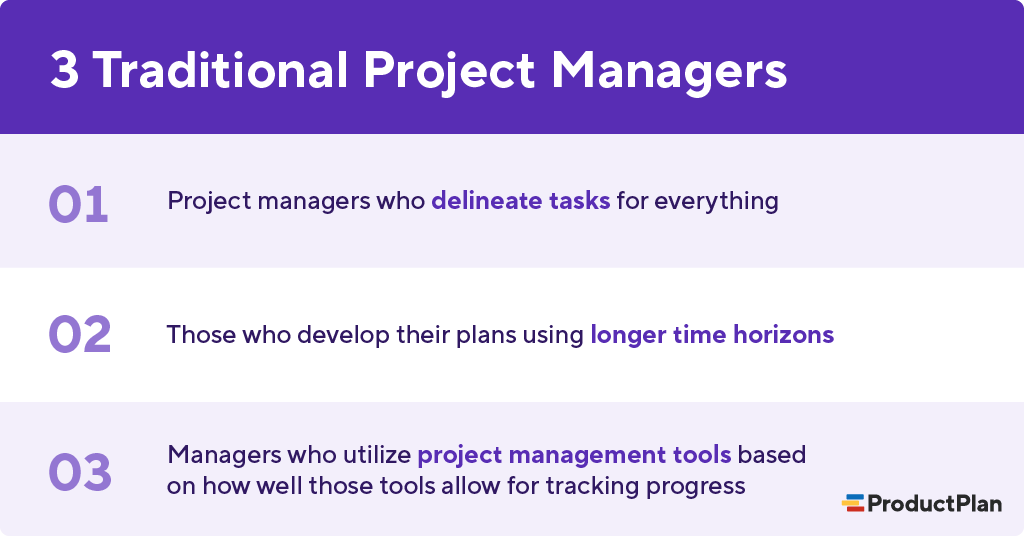The idea of agile project management might strike you as wishful thinking at first. It’s like the notion of limiting yourself to just one more episode of your favorite show on Netflix. It sounds like a brilliant idea. It would be great if you could pull it off. But in reality, it probably can’t be done.
Many project managers have been trained to think of project management as essentially the opposite of the agile approach. Consider, for example, those traditional project managers:

Every Project Serves a Strategy
Sometimes, even a conscientious project manager may miss a fundamental component of the job: Strategy.
An essential benefit of the agile methodology is that it encourages frequent reviewing and retooling of current plans. These professionals update the plans based on new information that the team continually gathers and analyzes.
In other words, the agile methodology lets a product team adjust its priorities and plans. These teams do not get stuck in an outdated plan simply because they have committed to seeing it through.
So, the question is: Why on earth wouldn’t a project manager also want to take this approach?
Shouldn’t every project benefit from being overseen from a strategic vantage point? Shouldn’t a project manager, just like a product manager, always want to keep one eye on the big strategic picture? And adjust their plans accordingly when doing so will likely improve the project’s chances for success?
We describe in detail here the distinction between project management and product management.
How Does Agile Project Management Work?
Suppose you’re a project manager and want to try the agile project management methodology. Doing so might be simpler than you think because it doesn’t require a company discussion. In that case, arguably, all you will need is a willingness to change your approach. In other cases, perhaps introduce one new tool.
To try agile project management on an initiative at your company, you could implement something like this simple three-step process:
1. Break your long-term plans into shorter-timeframe “project sprints.”
Traditional project management would have you draft one monster-sized plan for assigning and tracking all of your initiative’s tasks and milestones, using a project management tool such as Microsoft Project. This plan might include hundreds of details and run many months or even a year into the future.
The problem is, that plan would probably be at least somewhat outdated the day you publish it to your organization. The plan could become obsolete based on personnel changes or budgetary adjustments. Moreover, changing company priorities, and other realities may also affect the plan.
With agile project management, you can more strategically prepare for these changing realities by breaking the plan down into smaller, shorter sprints — as agile product managers do.
Say you’re overseeing your company’s event calendar for the year. Rather than developing a single, enormous year-long project management plan that included all of the details required to pull off your participation at all of the year’s events, you’d instead develop an “event sprint” — may be focused only on the first tradeshow where your company is set to exhibit.
Because you are focused entirely on a near-term project, the people involved will be more likely to give it their attention and effort, and you won’t waste time discussing ideas and plans for tradeshows many months away.
Moreover, because you haven’t set in stone a detailed plan for all future events, you have the flexibility to review the results of this tradeshow and apply your learnings from it — what worked, what didn’t — to the next short-term event sprint you develop.
2. Study and analyze the results of those shorter-timeframe sprints
Here again, you will be breaking with traditional project management principles, which would have you focused primarily (or even entirely) on whether or not your team members finished the tasks assigned to them by their deadlines.
As an agile project manager, by contrast, you will take one eye off the plan’s details and see how the results of that plan played out for the company.
Did the project as you executed it work as well as it could have? What planning approaches can you change to improve the outcome next time?
Because you are breaking your project into sprints, each newsprint has the opportunity to benefit from your learnings. In other words, you are now applying strategic reasoning to the details you draft. By adjusting those details based on new realities and what they suggest about your ability to meet your project’s strategic goals.
This is true agile project management.
3. Complement your sprint plan with a project roadmap
Finally, because you are approaching your project more strategically, you will want to add a strategic tool to your toolbox — a roadmap.
Yes, roadmaps are traditionally associated with product development. But when you consider an agile roadmap’s true purpose — to concisely document and communicate the strategic goals behind an initiative — you can understand why roadmaps are used for all sorts of projects.
Intelligent project management still requires using a tool to track and update the project details and enable fast and convenient communication among your team. Purpose-built project management tools, like JIRA and Pivotal Tracker, will still form the cornerstone of your team’s task management and give you a clear view of their day-to-day progress.
But your new agile project management approach also calls for a more strategic level view of the plan — a project roadmap, ideally one you can build using an intuitive, purpose-built roadmap tool.
Your project roadmap will allow you to capture and articulate your strategic thinking for designing and executing the plan in the specific way you’ve decided to do so.
This will prove to be a valuable document throughout the process in that it will give you a quick way to check in periodically to make sure you are still on track with your strategic goals, and it will help you communicate to your team why they are doing what you’re asking them to do.
Suppose you execute this part of the agile project management approach correctly. In that case, the process of using two tools — one for tracking the details, the other for communicating the high-level strategy — will be smooth and straightforward. Indeed, the best purpose-built roadmap tools integrate seamlessly with your project management software.
Agile Project Management is Smart Project Management
A well-known military saying: “All plans are great until the first shot is fired.”
As a project manager, you think in terms of creating and executing. Static, long-term plans lose strategic value quickly.
With that in mind, your instinct to try the agile project management approach is a smart one. We hope you will follow the simple three-step process outlined here and give this new approach a try. If you do, please let us know how it works for you and your team.



